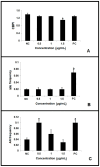Anticancer Potential and Safety Profile of β-Lapachone In Vitro
- PMID: 38543031
- PMCID: PMC10975997
- DOI: 10.3390/molecules29061395
Anticancer Potential and Safety Profile of β-Lapachone In Vitro
Abstract
Ipê is a plant of the Bignoniaceae family. Among the compounds extracted from this tree, lapachol is notable because its structural modification allows the production of β-lapachone, which has anticancer properties. The objective of this work was to test this hypothesis at a cellular level in vitro and assess its potential safety for use. The following tests were performed: MTT cell viability assay, apoptotic index determination, comet assay, and micronucleus test. The results showed that β-lapachone had a high cytotoxic capacity for all cell lines tested: ACP02 (gastric adenocarcinoma cells), MCF7 (breast carcinoma cells), HCT116 (colon cancer cells) and HEPG2 (hepatocellular carcinoma cells). Regarding genotoxicity, the exposure of cells to sublethal doses of β-lapachone induced DNA damage (assessed by the comet assay) and nuclear abnormalities, such as nucleoplasmic bridges and nuclear buds (assessed by the micronucleus test). All tested cell lines responded similarly to β-lapachone, except for ACP02 cells, which were relatively resistant to the cytotoxic effects of the compound in the MTT test. Our results collectively indicate that although β-lapachone showed antiproliferative activity against cancer cell lines, it also caused harmful effects in these cells, suggesting that the use of β-lapachone in treating cancer should be carried out with caution.
Keywords: Ipê; antiproliferative activity; apoptosis; genotoxicity; mutagenicity.
Conflict of interest statement
The authors declare no conflicts of interest.
Figures






References
-
- Pandey M., Debnath M., Gupta S., Chikara S.K. Phytomedicine: An ancient approach turning into future potential source of therapeutics. J. Pharmacogn. Phytother. 2011;3:27–37.
-
- Stankovic M.S., Radic Z.S., Blanco-Salas J., Vázquez-Pardo F.M., Ruiz-Téllez T. Screening of selected species from Spanish flora as a source of bioactive substances. Ind. Crops Prod. 2017;95:493–501. doi: 10.1016/j.indcrop.2016.09.070. - DOI
-
- Aleebrahim-Dehkordy E., Rafieian-Kopaei M., Amini-Khoei H., Abbasi S. In Vitro Evaluation of Antioxidant Activity and Antibacterial Effects and Measurement of Total Phenolic and Flavonoid Contents of Quercus brantii L. Fruit Extract. J. Diet. Suppl. 2019;16:408–416. doi: 10.1080/19390211.2018.1470126. - DOI - PubMed
-
- Pradeep K.S., Mallya P., Jain V. Naphthoquinones in the Treatment of Cancer. Pharm. J. Pharm. Sci. Res. 2020;12:587–590.
MeSH terms
Substances
Grants and funding
LinkOut - more resources
Full Text Sources

